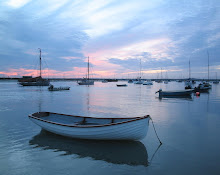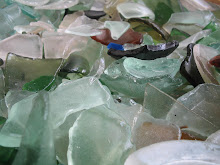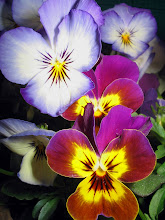 Bamburgh Castle from Lindisfarne.
Bamburgh Castle from Lindisfarne.And I will start right back on 20 October, when I arrived on the island of Lindisfarne.
Although it lies only a short distance offshore and is, like Mersea, accessible by road via a causeway, Lindisfarne (unlike Mersea) is cut off from the mainland by the tides twice every day. This, together with its location on the wild and beautiful Northumbrian coast, lends a sense of remoteness and romanticism to the island. But its extraordinary history as the 'cradle' of Christianity in England - reflected in its alternative official name, Holy Island - adds layer upon layer of atmosphere, making it a tangibly spiritual place, even to those of little faith or none.

Banburgh centre, Farne Islands far left.
Lindisfarne's most famous religious figure is St Cuthbert, an Anglo-Saxon monk and missionary who, in 676 adopted the solitary life and retired to a cave. After a time he settled in a cell on one of the Farne Islands. In 684, he was elected Bishop of Lindisfarne, but two years later, missing the solitude, he returned to his cell on Inner Farne, where he eventually died.
In the early 700s the famous illuminated manuscript now known as the Lindisfarne Gospels, an illustrated Latin copy of the Gospels of Matthew, Mark, Luke and John, was made probably at Lindisfarne and the artist was possibly Eadfrith, who later became Bishop of Lindisfarne.
 (To see a 'turn the pages' online version of the Gospels go here and then click on 'Pinnacle of Anglo-Saxon Art, third down, left-hand column', which will download the necessary Shockwave Player if you don't already have one.)
(To see a 'turn the pages' online version of the Gospels go here and then click on 'Pinnacle of Anglo-Saxon Art, third down, left-hand column', which will download the necessary Shockwave Player if you don't already have one.) 
At the end of the eighth century, a Viking raid on Lindisfarne overturned the monastic peace of the island. The Anglo-Saxon Chronicle records:
'In this year fierce, foreboding omens came over the land of Northumbria. There were excessive whirlwinds, lightning storms, and fiery dragons were seen flying in the sky. These signs were followed by great famine, and on January 8th the ravaging of heathen men destroyed God's church at Lindesfarne.'
while Alcuin, an English monk of the period, wrote:
'Never before has such terror appeared in Britain as we have now suffered from a pagan race . . . The heathens poured out the blood of saints around the altar, and trampled on the bodies of saints in the temple of God, like dung in the streets.'

Eventually the monks fled the island (taking with them the body of St Cuthbert, which is now buried at Durham Cathedral) and the bishopric was transferred to Durham in AD 1000. The Lindisfarne Gospels now reside in the British Library in London.
The Priory was re-established in the twelfth century as a Benedictine house and continued until its suppression in 1536 under Henry VIII.
The ruins - built in sandstone of the most glowing pink - are still substantial enough to give a very good impression of the original grandeur and extent of the church and monastery.


 These Romanesque arches in the nave are reminiscent of those in Durham Cathedral.
These Romanesque arches in the nave are reminiscent of those in Durham Cathedral.
 St Aidan.
St Aidan.
 St Mary's Church.
St Mary's Church.  Lindisfarne Castle, based on a Tudor fort and built high on a volcanic plug which towers above the rest of the island, was refurbished in the Arts and Crafts style by Edwin Lutyens for the editor of Country Life, Edward Hudson. (Lutyens also designed the island's Celtic-cross war-memorial on the Heugh.) Gertrude Jekyll, laid out a tiny garden just north of the castle in 1911.
Lindisfarne Castle, based on a Tudor fort and built high on a volcanic plug which towers above the rest of the island, was refurbished in the Arts and Crafts style by Edwin Lutyens for the editor of Country Life, Edward Hudson. (Lutyens also designed the island's Celtic-cross war-memorial on the Heugh.) Gertrude Jekyll, laid out a tiny garden just north of the castle in 1911.
 My photos of the island's fascinating boatsheds are posted here. The beaches held many other delights - including a copious quantity of (you've guessed it!) sea glass, and masses of the kind of boatyfishyropey junk I just can't keep away from:
My photos of the island's fascinating boatsheds are posted here. The beaches held many other delights - including a copious quantity of (you've guessed it!) sea glass, and masses of the kind of boatyfishyropey junk I just can't keep away from:







 I stayed at The Ship Inn - a warm and cosy traditional pub, with very friendly service from landlords Andrew and Janice. But, oh dear, I guzzled soooo many calories that week, and this tendency began in earnest on Holy Island. I’m simply incapable, when asked ‘would you like full English breakfast this morning?’, of saying ‘no, I’ll just have a small orange juice, thanks’. And the same goes for ‘‘would you like a slice of cake with that cup of coffee?’
I stayed at The Ship Inn - a warm and cosy traditional pub, with very friendly service from landlords Andrew and Janice. But, oh dear, I guzzled soooo many calories that week, and this tendency began in earnest on Holy Island. I’m simply incapable, when asked ‘would you like full English breakfast this morning?’, of saying ‘no, I’ll just have a small orange juice, thanks’. And the same goes for ‘‘would you like a slice of cake with that cup of coffee?’Systematic calorie intake took place at several venues, among them my base, The Ship, where portions are huge and the puds defeated even greedy old moi; Pilgrims Café (just an abstemious coffee with no cake) - very cosy and getting Christmassy already; and, my favourite in every way, Café Bean Goose, where I enjoyed a bowl of the most delicious spicy vegetable soup one lunchtime and then returned on my final morning for an abstemious coffee but ended up having a giant cappuccino and a slice of the most delicious chocolate tiffin I've ever tasted (made with a combination of Green & Blacks and Montezuma chocolate, sour cherries, sultanas and digestive biscuits).

 The words 'yummy' and 'scrummy' simply do not convey the half of it. I shall be back. It would be worth the train fair just to go there for the tiffin, frankly.
The words 'yummy' and 'scrummy' simply do not convey the half of it. I shall be back. It would be worth the train fair just to go there for the tiffin, frankly.
Well, that was the first part of my little northeasterly hol. The weather, as can be seen from the photographs, was beautiful, with cloudless skies and cool, clean air. And when night fell, I don't recall having seen the starry heavens in quite such sharp detail before. Perfect.
Do visit Holy Island if you ever get the chance. The island's official website provides masses of information. And I'd also recommend Magnus Magnusson's book Lindisfarne: The Cradle Island.

Here's what Thomas Girtin made of Lindisfarne Priory:

And Turner:

Better go and do some more scribbling now . . .

























9 comments:
Thanks for the wonderful description and photos, J. You took me right back to one of my favourite places and made me think I must make a return visit very soon.
Oh, I want to go there immediately and connect with my north-eastern roots! (I even named one of the cats after the saint . . .)
Fabulous, atmospheric photos, J. Food sounds pretty good too.
Hi M & D - maybe an ideal venue for a bloggers' long weekend away sometime?? An ideal place for reading and reflection and simply 'being'. And yes, excellent food everywhere - much to the detriment of the waistline, but ho hum. Which saint, D? Aidan or Cuthbert? I like the sound of 'Cuthbert the cat', I must say.
Welcome back! The wonderful photos remind me how sorry I am that, on my one visit near Lindisfarne, the causeway disappeared under water even as my car approached it....
Wow. I am staggered. If I had a prize to give for single most fabulous blog post (beautiful pictures, educational, informational) this would be it! Oh, and I sooo want to go there now. I think I want to live there. Maybe I will create a prize...
Thanks for the great post! It's been a year since I've been on Lindisfarne, and I am aching to return.
It's Cuthbert, J. The twin brother of the oh-so-poorly Clarence . . .
What an astonishing photo essay! Gobsmackingly beautiful!
This is wonderful, I'll be linking to this post from the Saint Cuthbert blog I'm starting.
Post a Comment